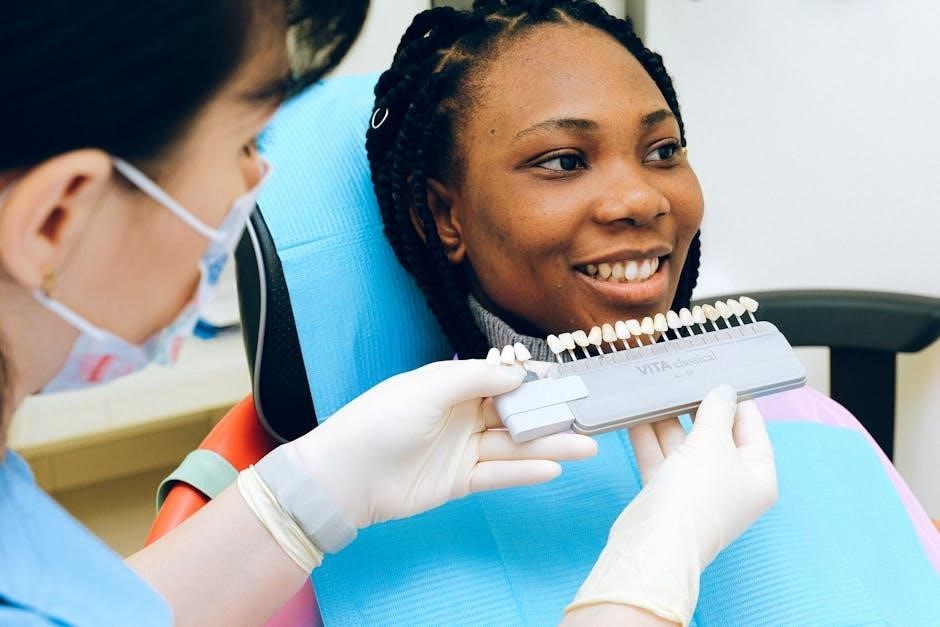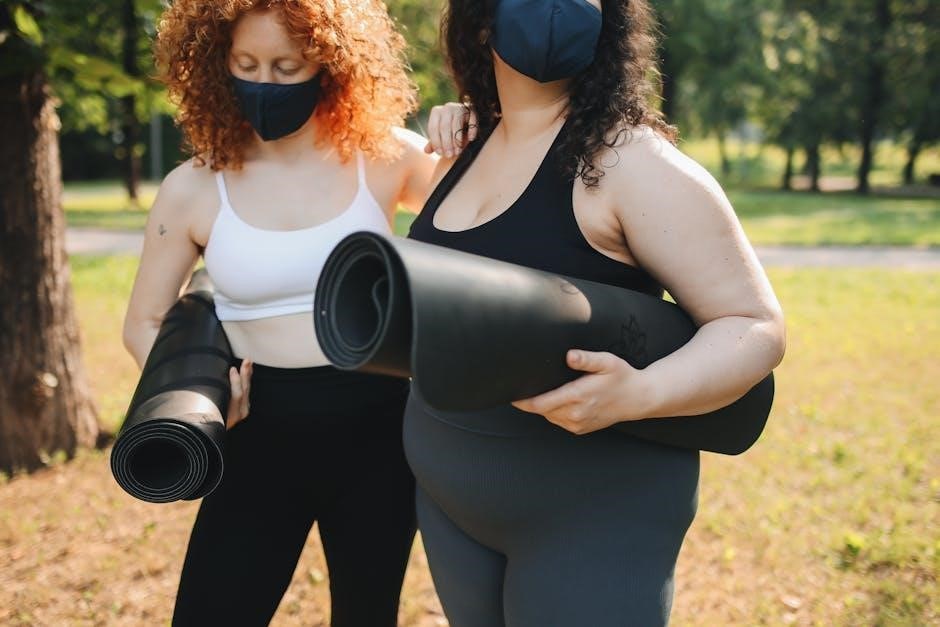Importance of Proper CPAP Mask Sizing
A well-fitted CPAP mask ensures comfort, prevents skin irritation, and avoids air leaks, enhancing therapy effectiveness and improving sleep quality for better health outcomes.
1.1 Why Proper Sizing Matters
Proper CPAP mask sizing is crucial for effective therapy and comfort. A well-fitted mask prevents air leaks, skin irritation, and dry mouth, ensuring consistent airflow and improved sleep quality. Proper sizing also enhances comfort, reducing discomfort and promoting adherence to treatment. Accurate fit ensures the mask seals correctly, maintaining therapeutic pressure and optimizing health outcomes for sleep apnea patients.
1.2 Comfort and Effectiveness of Well-Fitted Masks
A well-fitted CPAP mask ensures maximum comfort and effectiveness. It provides a leak-free seal, promoting consistent airflow and preventing dry mouth or skin irritation. Properly sized masks reduce discomfort, allowing for uninterrupted sleep and better therapy adherence. This leads to improved sleep quality and overall health outcomes, making CPAP therapy more manageable and effective for sleep apnea patients.

Types of CPAP Masks and Their Sizing
CPAP masks come in nasal, nasal pillow, and full-face styles, each requiring specific sizing to ensure proper fit and comfort for effective therapy.
2.1 Nasal Masks
Nasal masks cover the nose, ideal for nasal breathers. They come in various sizes, measured by nose width and height. Proper sizing ensures a leak-free seal, comfort, and effectiveness. Use a ruler or printable templates to determine your size, matching measurements to charts for a perfect fit. This ensures optimal CPAP therapy and better sleep quality;
2.2 Nasal Pillow Masks
Nasal pillow masks feature small cushions that fit directly into the nostrils. They are lightweight and ideal for those who prefer minimal contact. Sizing focuses on nostril size, using gel pillows for comfort. Proper fit ensures no air leaks and reduces irritation. Measure nostril width and height, matching to sizing charts for the best fit and therapy effectiveness.
2.3 Full-Face Masks
Full-face masks cover both the nose and mouth, ideal for mouth breathers or those with nasal congestion. Proper sizing ensures a secure seal and comfort. Measure nose height and width, and mouth width using a ruler or printable template. A well-fitted mask prevents leaks and ensures consistent airflow, enhancing therapy effectiveness and promoting better sleep quality for users with diverse breathing patterns.

How to Measure for the Right Fit
Use a ruler or measuring tape to measure nose height, width, and mouth width. Printable templates ensure accuracy, matching your dimensions to sizing charts perfectly.
3.1 Using a Ruler or Measuring Tape
Measure your nose height and width using a ruler or measuring tape. Align the ruler with the bridge of your nose and note the width across the nostrils. For full-face masks, also measure the distance from the bridge to your chin. These measurements help match your face to the sizing chart, ensuring a precise fit and avoiding sizing errors.
3.2 Printable Sizing Templates
Printable sizing templates provide precise measurements for CPAP masks. Download and print the template at 100% size to ensure accuracy. Hold the template against your face, aligning it with your nose and facial features. This method helps determine the correct cushion size for nasal or full-face masks, ensuring a comfortable and secure fit tailored to your facial structure.

Understanding CPAP Mask Sizing Charts
CPAP mask sizing charts provide detailed measurements and guidelines to help users select the correct size, ensuring a proper fit for effective therapy.
4.1 Interpreting Measurements
Interpreting CPAP mask measurements involves comparing nasal width, height, and cushion sizes against the chart. Use a ruler to measure from the nostrils’ widest points and match to the chart for accurate sizing. Proper alignment ensures a leak-free seal, maximizing comfort and therapy effectiveness. Always follow the manufacturer’s specific guidelines for precise fit.
4.2 Matching Measurements to Mask Sizes
Once measurements are taken, align them with the manufacturer’s sizing chart to identify the correct mask size. For nasal masks, match nose width and height to the chart, while full-face masks require additional facial dimensions. Ensure the cushion size corresponds to your measurements for a secure, leak-free fit, enhancing CPAP therapy comfort and effectiveness.

Choosing the Right Mask Style for Your Needs
Selecting a mask style depends on your lifestyle, comfort preferences, and facial structure. Consider nasal, nasal pillow, or full-face masks to ensure a secure, comfortable fit tailored to your needs.
5.1 Lifestyle and Comfort Preferences
Your lifestyle and comfort preferences play a crucial role in selecting a CPAP mask. Active sleepers may prefer lightweight nasal pillow masks, while side sleepers might opt for full-face masks to avoid leakage. Consider your comfort needs, such as skin sensitivity or claustrophobia, to choose between nasal, nasal pillow, or full-face options. Ensure the mask aligns with your sleeping position and personal comfort for effective therapy.
5.2 Facial Structure and Mask Compatibility
Your facial structure significantly impacts mask compatibility. Measure your nose width, height, and shape to determine the best fit. Narrow noses may suit nasal masks, while wider noses prefer full-face options. Nostril size is crucial for nasal pillow masks, ensuring comfort and seal. Use sizing guides to match your features with the appropriate mask type, ensuring a leak-free and comfortable fit tailored to your unique facial contours.

Advanced Fitting Technologies
Advanced tools like MaskFit AR use augmented reality to virtually try on masks, ensuring precise sizing and personalized fit recommendations based on your unique facial measurements.
6.1 MaskFit AR and Other Digital Tools
MaskFit AR and similar digital tools utilize augmented reality to provide precise CPAP mask sizing. Users can virtually try on masks, ensuring a perfect fit by matching their facial measurements to the ideal size. These technologies enhance comfort and reduce trial-and-error, making the selection process efficient and personalized for optimal therapy outcomes and user satisfaction.

Adjusting Your CPAP Mask for Optimal Comfort
Proper CPAP mask adjustment ensures a snug fit, minimizing leaks and maximizing comfort during sleep therapy. Adjust headgear and cushion sizes for a personalized fit.
7.1 Tips for a Leak-Free Seal
Ensure a leak-free seal by using a ruler or printable templates to measure your face accurately. Adjust headgear and cushion sizes for a snug fit without over-tightening. Check mask position and cushion size regularly for comfort and effectiveness. Proper sizing prevents air leaks, ensuring consistent therapy and better sleep quality. Refer to CPAP mask sizing charts for precise measurements.
7.2 Customizing Fit for Different Face Shapes
Customize your CPAP mask fit by using sizing templates or measuring tools to match your facial dimensions. For narrow faces, opt for petite or small sizes, while broader faces may require medium or large sizes. Adjust headgear to ensure even pressure without over-tightening. Ensure the cushion fits snugly around the nose or mouth, depending on the mask type, for optimal comfort and performance.

Maintenance and Care for Your CPAP Mask
Regularly clean and sanitize your CPAP mask to maintain hygiene and ensure optimal performance. Replace worn-out parts to preserve the fit and functionality of your mask.
8.1 Cleaning and Sanitizing
Clean your CPAP mask daily with mild soap and warm water to remove dirt and oils. Rinse thoroughly and air-dry to prevent bacteria growth. Regular sanitizing with approved cleaners ensures hygiene and maintains mask performance. Avoid harsh chemicals that may damage the material. For convenience, consider using automated cleaning devices designed for CPAP equipment. Proper care extends the life of your mask and ensures effective therapy.
8.2 Replacing Parts for Consistent Fit
Regularly replace CPAP mask parts like cushions and headgear to maintain a consistent fit. Over time, these components can wear out, leading to air leaks and discomfort. Monitor for signs of deterioration, such as cracks or stretching, and refer to the product’s sizing chart for guidance. Replace nasal pillows or cushions when they no longer seal properly. Timely replacements ensure optimal comfort, hygiene, and therapy effectiveness. Proper fit is key to successful CPAP treatment.

Common Mistakes to Avoid
Common mistakes include improper sizing techniques and ignoring mask maintenance, which can lead to discomfort and ineffective therapy. Always use sizing guides and replace worn parts.
9.1 Improper Sizing Techniques
Improper sizing techniques, such as guessing your size or not using a sizing guide, can lead to poor fit, air leaks, and discomfort. Always measure accurately and consult charts to avoid these issues, ensuring effective therapy and comfort during sleep.
9.2 Ignoring Mask Maintenance
Neglecting to clean and sanitize your CPAP mask can lead to bacterial growth, skin irritation, and reduced effectiveness. Regular maintenance ensures a hygienic and comfortable fit, preventing potential health issues and extending the mask’s lifespan for optimal therapy results.

Troubleshooting Fit Issues
Addressing air leaks and discomfort is crucial for effective CPAP therapy. Adjusting the mask fit, ensuring proper cushion sizing, and consulting a professional can resolve common issues, ensuring optimal comfort and therapy outcomes.
10.1 Addressing Air Leaks and Discomfort
Air leaks and discomfort can disrupt therapy. Check for proper mask fit, ensuring the cushion seals without over-tightening. Use a sizing guide to confirm correct measurements. Adjust headgear for even pressure, and consider replacing worn-out parts. If issues persist, consult a professional for personalized adjustments or mask recommendations to ensure a leak-free, comfortable fit and effective CPAP therapy.
10.2 When to Consult a Professional
If air leaks or discomfort persist despite adjustments, consult a CPAP specialist. They can assess facial structure and recommend tailored solutions. Professionals may use advanced tools like MaskFit AR to ensure optimal fit. Their expertise helps resolve complex sizing issues, ensuring therapy effectiveness and comfort, and addressing unique needs for a personalized approach to mask fitting and CPAP therapy success.